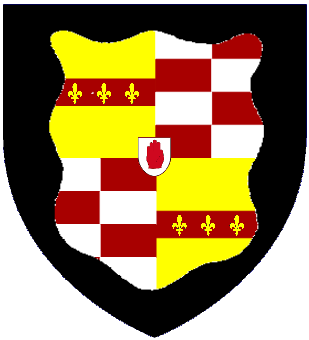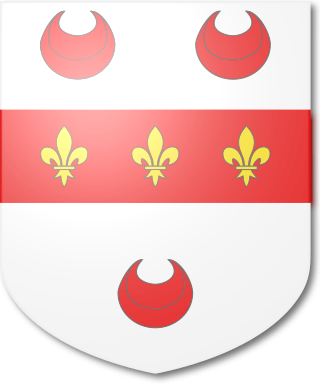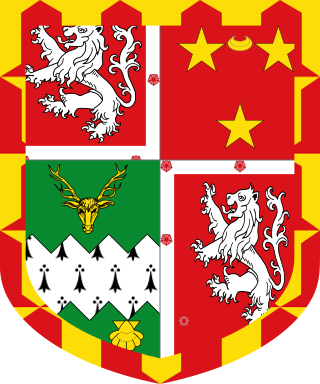The Duff, later Duff Gordon Baronetcy, of Halkin in the County of Aberdeen, is a title in the Baronetage of the United Kingdom. It was created on 12 November 1813 for James Duff, British Consul in Cádiz, with remainder to his nephew, William Gordon.

The Bunbury Baronetcy, of Bunbury, Oxon and Stanney Hall in the County of Chester, is a title in the Baronetage of England. It was created on 29 June 1681 for Thomas Bunbury, Sheriff of Cheshire from 1673 to 1674 and the member of an ancient Cheshire family. His grandson, Henry, the third Baronet, and great-grandson, the fourth Baronet, both sat as Members of Parliament for Chester. The latter died unmarried at an early age and was succeeded by his younger brother, the fifth Baronet. He was a clergyman. On his death in 1764 the title passed to his eldest son, the sixth Baronet. He represented Suffolk in the House of Commons for over forty years but is best remembered for his marriage to Lady Sarah Lennox. He died childless in 1821 and was succeeded by his nephew, the seventh Baronet. He was the son of Henry Bunbury, younger son of the fifth Baronet. The seventh Baronet was a distinguished soldier and politician. His eldest son, the eighth Baronet, was High Sheriff of Suffolk in 1868, and Fellow of the Royal Society. He died childless in 1886 and was succeeded by his younger brother, the ninth Baronet. He was Liberal Member of Parliament for Bury St Edmunds. He died unmarried in 1895 and was succeeded by his nephew, the tenth Baronet. He was the son of Colonel Henry William St Pierre Bunbury, third son of the seventh Baronet. He served as High Sheriff of Suffolk in 1908 and was a Deputy Lieutenant of the county. On his death in 1930 the title passed to his son, the eleventh Baronet. He was High Sheriff of Suffolk in 1936 and was a Deputy Lieutenant of the county. His son, the twelfth Baronet, was High Sheriff of Suffolk in 1972. As of 2014 the title was held by the latter's second but eldest surviving son, the thirteenth Baronet, who succeeded in 1985.
Sir Frederick Fergus Graham, 5th Baronet KBE TD was a Conservative Party politician in the United Kingdom.

The Wigram Baronetcy, of Walthamstow House in the County of Essex, is a title in the Baronetage of the United Kingdom. It was created on 30 October 1805 for Robert Wigram, a successful shipbuilding merchant and politician, representing Fowey and Wexford Borough in the House of Commons. The second Baronet also represented Wexford Borough in Parliament. He assumed in 1832 by Royal licence the surname of Fitzwygram. The fourth Baronet was a Lieutenant-General in the army and sat as a Conservative Member of Parliament for South Hampshire and Fareham.

The Barrett-Lennard Baronetcy, of Belhus in the County of Essex, is a title in the Baronetage of the United Kingdom. It was created on 30 June 1801 for Thomas Barrett-Lennard, subsequently Member of Parliament for Essex South. He was the illegitimate son and testamentary heir of Thomas Barrett-Lennard, 17th Baron Dacre. He was succeeded by his grandson, the second Baronet, the son of Thomas Barrett-Lennard, Member of Parliament for Maldon. His son, the third Baronet, was childless and was succeeded by his younger brother, the fourth Baronet. This line of the family failed on the death in 1977 of his son, the fifth Baronet, who died without male issue. The late Baronet was succeeded by his third cousin once removed, the sixth Baronet. He was the son of Sir Fiennes Cecil Arthur Barrett-Lennard, Chief Justice of Jamaica, son of Captain Thomas George Barrett-Lennard, son of the first marriage of George Barrett-Lennard, son of John Barrett-Lennard, second son of the first Baronet. The sixth Baronet was a Catholic clergyman. As of 2014 the title is held by his second cousin, the seventh Baronet, who succeeded in 2007. He is the grandson of Trenchard Barrett-Lennard, son of the aforementioned George Lennard-Barrett by his second marriage. As of 31 December 2013 the present Baronet has not successfully proven his succession and is therefore not on the Official Roll of the Baronetage, with the baronetcy considered vacant since 2007.
The Langham Baronetcy, of Cottesbrooke in the County of Northampton, is a title in the Baronetage of England. It was created on 7 June 1660 for John Langham, Member of Parliament for the City of London in 1654 and for Southwark in 1660 and 1661. The second Baronet was Member of Parliament for Northamptonshire and Northampton while the third Baronet sat for Northampton. The seventh Baronet was Member of Parliament for Northamptonshire. The tenth Baronet represented St Germans in the House of Commons. The thirteenth Baronet was a photographer, ornithologist and entomologist and served as High Sheriff of County Fermanagh in 1930.

The Oakeley Baronetcy, of Shrewsbury, is a title in the Baronetage of Great Britain. It was created on 5 June 1790 for the Indian administrator Charles Oakeley. He served as Governor of Madras from 1790 to 1794. Frederick Oakeley was the second son of the first Baronet.

The Price, later Rugge-Price Baronetcy, of Spring Grove in Richmond in the County of Surrey, is a title in the Baronetage of the United Kingdom. It was created on 2 February 1804 for Charles Price, Member of Parliament for the City of London from 1802 to 1812 and Lord Mayor of London from 1802 to 1803. The fifth Baronet assumed in 1874 by Royal licence the additional surname of Rugge. As of 28 February 2014 the present Baronet has not successfully proven his succession and is therefore not on the Official Roll of the Baronetage, with the baronetcy considered dormant since 2000.

The Pigot Baronetcy, of Patshull Hall in the County of Stafford, is a title in the Baronetage of Great Britain. It was created on 5 December 1764 for the politician and colonial administrator George Pigot, with remainder to his brothers General Robert Pigot and Admiral Hugh Pigot, and remains extant. On 19 January 1766 Pigot was further honoured when he was raised to the Peerage of Ireland as Baron Pigot, with normal remainder to the heirs male of his body. Lord Pigot was unmarried and on his death in 1777 the barony became extinct. He was succeeded in the baronetcy according to the special remainder by his brother, Robert, the second Baronet. He was a distinguished soldier.

The Palmer Baronetcy, of Carlton in the County of Northampton, was created in the Baronetage of England on 7 June 1660 for the lawyer and politician Geoffrey Palmer. The second Baronet was Member of Parliament for Higham Ferrers. The third, fourth and fifth Baronets all represented Leicestershire in the House of Commons. The fifth Baronet served as High Sheriff of Leicestershire in 1782 and the eighth Baronet as High Sheriff of Northamptonshire in 1871.
The Robinson Baronetcy, of London, was created in the Baronetage of England on 22 June 1660 for John Robinson, Lord Mayor of London and Member of Parliament for the City of London and Rye. He was the nephew of Archbishop William Laud. The fifth and sixth Baronets both represented Northampton in the House of Commons.
Sir John Lowther Johnstone, 6th Baronet (1783–1811) was a British Army officer and politician.
Sir James Graham, 1st Baronet was a British Tory politician.

The Shelley baronetcy, of Michelgrove in the County of Sussex, was created in the Baronetage of England on 22 May 1611 for John Shelley.

The Cholmeley baronetcy, of Easton in the County of Lincoln, was created in the Baronetage of the United Kingdom on 4 March 1806 for Montague Cholmeley, subsequently Member of Parliament for Grantham. His son, the second Baronet, sat as Member of Parliament for North Lincolnshire. He was succeeded by his son, the third Baronet, who also represented Grantham as MP. His grandson, the fifth Baronet, was High Sheriff of Lincolnshire in 1961 and a Vice-Lord-Lieutenant and Deputy Lieutenant of the county.

The Graham baronetcy, of Esk (Eske) in the County of Cumberland, was created in the Baronetage of England on 29 March 1629 for Richard Graham (c.1583–1654). He represented Carlisle in Parliament, was a Gentleman of the Horse to King Charles I and fought at the Battle of Edgehill in 1642.

The Shaw baronetcy, of Bushy Park in the County of Dublin, was created in the Baronetage of the United Kingdom on 17 August 1821 for the Tory politician Robert Shaw. The 3rd Baronet was also a politician.

The Rowley baronetcy, of Tendring Hall (Stoke-by-Nayland) in the County of Suffolk, was created in the Baronetage of Great Britain on 27 June 1786 for the naval commander Rear-Admiral Joshua Rowley. He was the son of Admiral of the Fleet Sir William Rowley.

The Dunbar baronetcy of Hempriggs, Caithness, was created for Hon. James Dunbar, formerly James Sutherland, on 10 or 21 December 1706. He was a younger son of James Sutherland, 2nd Lord Duffus, and brother of the attainted Jacobite Kenneth Sutherland. He married Elizabeth Dunbar, daughter and heiress of Sir William Dunbar, 1st Baronet of the Dunbar baronets of Northfield (1700).

The Dundas baronetcy, of Beechwood in the County of Midlothian, was created in the Baronetage of the United Kingdom on 24 August 1821 for Robert Dundas. He was succeeded by his son David, the 2nd Baronet; three of his six sons, the 3rd, 4th and 5th Baronets, all succeeded in the title. The last was succeeded by his son, the 6h Baronet. He was childless and on his death in 1981 at the age of 99, the title became extinct.














